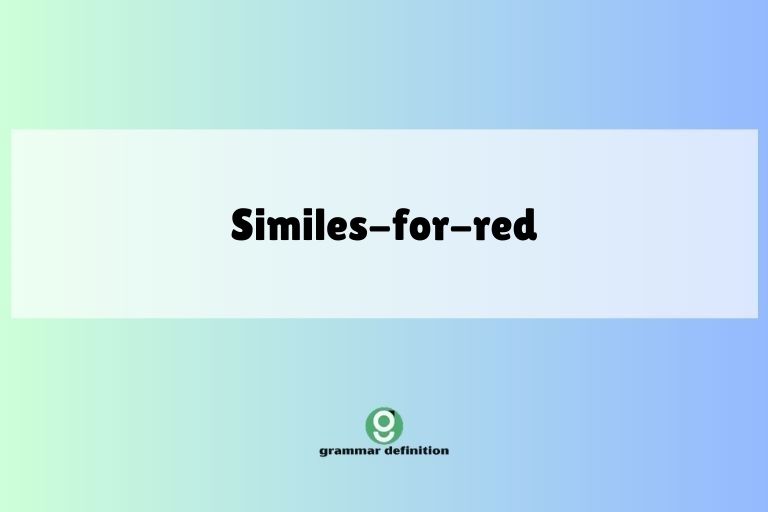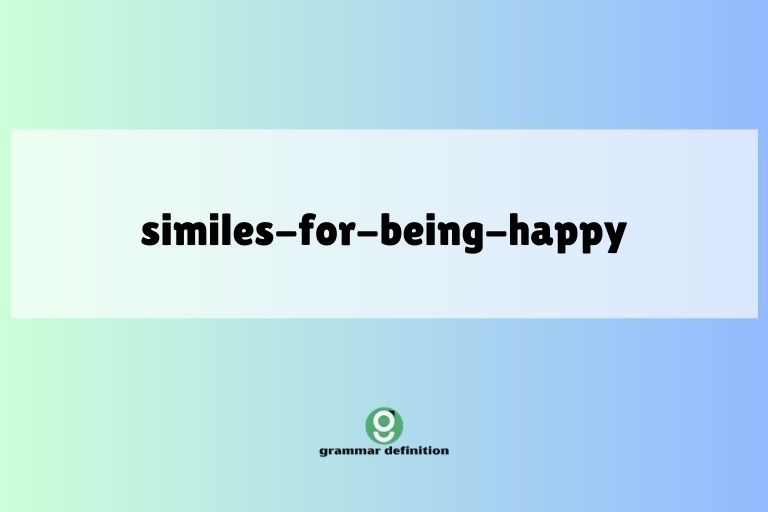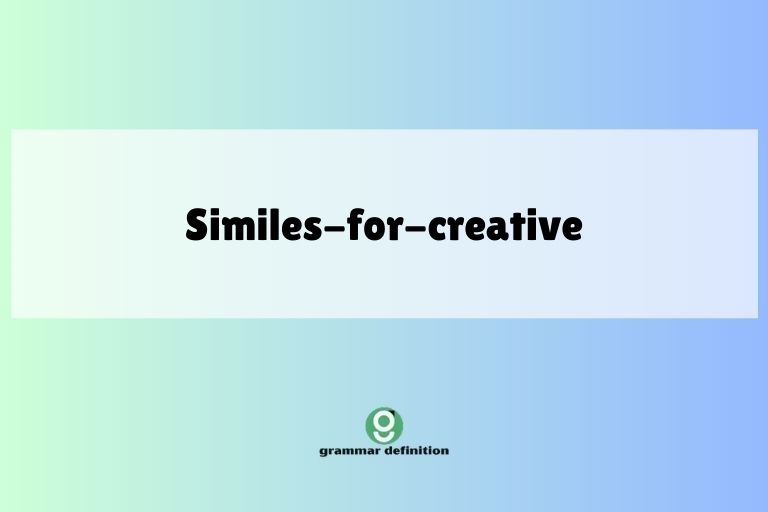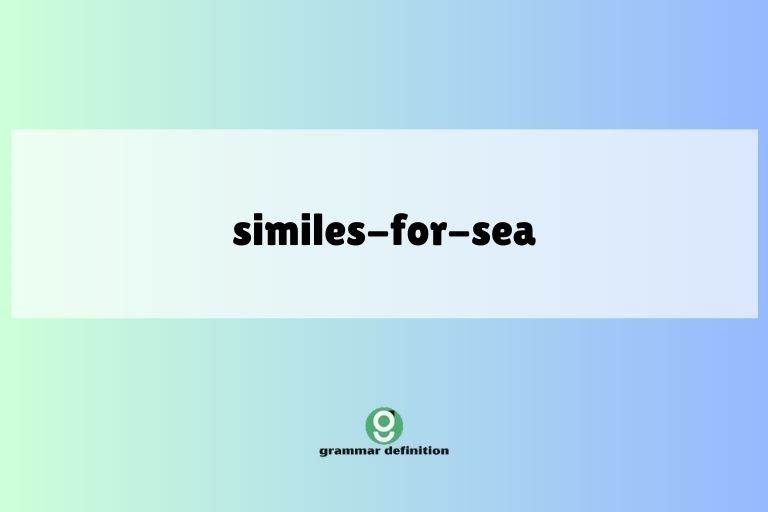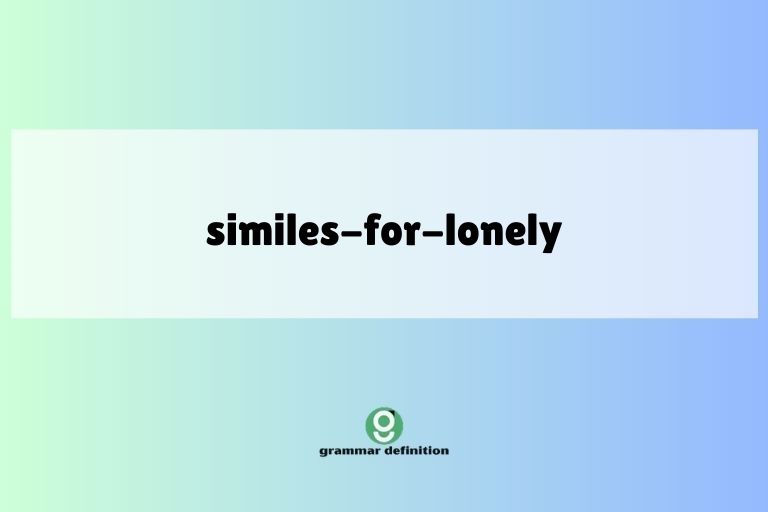Similes for Slow: A Comprehensive Guide to Descriptive Comparisons
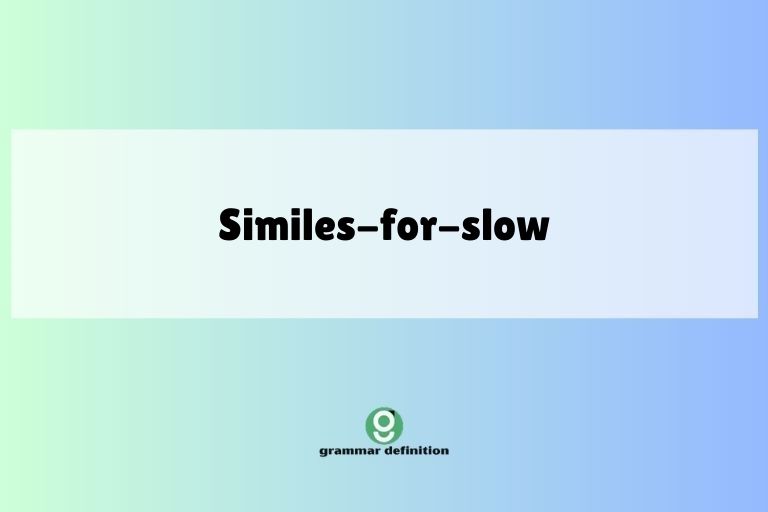
Similes are powerful tools in the English language, allowing us to paint vivid pictures with words by comparing one thing to another. When it comes to describing slowness, similes can be particularly effective.
This article provides a comprehensive exploration of similes used to convey the concept of “slow,” examining their structure, usage, and impact. Whether you’re a student, writer, or simply someone looking to enhance your vocabulary, this guide will equip you with the knowledge and resources to master the art of using similes to describe slowness effectively.
Understanding similes is crucial for enhancing both your writing and comprehension skills. They add depth and color to language, making descriptions more engaging and memorable.
By exploring the various similes used to describe slowness, we can gain a deeper appreciation for the nuances of the English language and improve our ability to express ourselves with precision and creativity. This article caters to English language learners, writers seeking to enrich their descriptive abilities, and anyone interested in improving their understanding of figurative language.
Table of Contents
- Definition of Similes
- Structural Breakdown of Similes
- Types of Similes
- Examples of Similes for Slow
- Usage Rules for Similes
- Common Mistakes with Similes
- Practice Exercises
- Advanced Topics in Similes
- Frequently Asked Questions
- Conclusion
Definition of Similes
A simile is a figure of speech that directly compares two unlike things using the words “like” or “as.” The primary function of a simile is to enhance the description of something by drawing a parallel to something else that shares a similar quality. Unlike metaphors, which imply a direct equivalence, similes acknowledge that the two things being compared are distinct but share a common attribute.
Similes add vividness and clarity to writing, making it more engaging and memorable. They fall under the broader category of figurative language, which also includes metaphors, personification, and hyperbole.
In the context of describing “slow,” similes help to illustrate the degree of slowness by comparing it to something that is universally recognized as slow-moving or gradual. This technique allows writers to convey the concept of slowness in a more relatable and impactful way.
For instance, saying someone is “as slow as a snail” immediately conjures an image of deliberate, unhurried movement.
Structural Breakdown of Similes
The basic structure of a simile consists of three main components: the subject, the linking word (“like” or “as”), and the comparative term. The subject is the thing being described, the linking word establishes the comparison, and the comparative term is the thing to which the subject is being compared. Understanding this structure is essential for creating and interpreting similes effectively.
Here’s a breakdown of the structural components:
- Subject: The entity or action being described (e.g., the car, the process).
- Linking Word: “Like” or “as” – the word that connects the subject and the comparative term.
- Comparative Term: The entity or action used for comparison, which shares a quality with the subject (e.g., a snail, molasses).
For example, in the simile “He moved as slow as molasses,” “He” is the subject, “as” is the linking word, and “molasses” is the comparative term. The simile suggests that his movement shares the characteristic of slowness with the viscous, slow-pouring nature of molasses.
Types of Similes
While all similes serve the same basic function of comparison, they can be categorized based on the type of comparative term used. This categorization can help in understanding the different nuances and effects that similes can create.
Here are a few common types of similes:
- Animal-Based Similes: These similes use animals to draw comparisons, often relying on common perceptions of animal behavior.
- Nature-Based Similes: These similes use elements of nature, such as landscapes, weather, or natural processes, for comparison.
- Object-Based Similes: These similes use inanimate objects as the basis for comparison.
- Abstract Similes: These similes use abstract concepts or ideas to draw comparisons.
- Food-Based Similes: These similes use food items to create comparisons.
Each type of simile can evoke different imagery and associations, making it important to choose the right type to effectively convey the intended meaning.
Examples of Similes for Slow
Here are various examples of similes used to describe slowness, categorized by type. Each example is designed to illustrate how similes can add depth and color to descriptions of slow movement, processes, or progress.
Animal-Based Similes
Animal-based similes often leverage common perceptions of animal behavior to convey slowness. Animals like snails, tortoises, and sloths are frequently used to represent slow movement or progress.
The following table provides examples of animal-based similes for “slow.”
| Simile | Explanation | Example Sentence |
|---|---|---|
| As slow as a snail | Snails are known for their deliberate, unhurried pace. | The traffic was as slow as a snail on the highway this morning. |
| As slow as a tortoise | Tortoises are famous for their slow and steady movement. | The old computer was as slow as a tortoise; it took forever to load a page. |
| As slow as a sloth | Sloths are notoriously slow-moving creatures. | He was moving as slow as a sloth, barely lifting his feet as he walked. |
| Like a turtle in molasses | Combines the slow image of a turtle with the viscous slowness of molasses. | Trying to get him to finish his chores was like pushing a turtle in molasses. |
| As sluggish as a hibernating bear | Refers to the inactivity and slow metabolism of a hibernating bear. | After the holiday feast, everyone felt as sluggish as a hibernating bear. |
| Slow like a caterpillar crawling | Caterpillars are known for their inching, slow movement. | The line at the DMV moved slow like a caterpillar crawling across a leaf. |
| As slow as a three-toed sloth climbing a tree | Emphasizes the extreme slowness of a three-toed sloth. | The project’s progress was as slow as a three-toed sloth climbing a tree. |
| Moving like a worm in dirt | Worms move slowly and deliberately through the soil. | The injured player was moving like a worm in dirt, struggling to reach the sidelines. |
| As gradual as a spider spinning its web | Refers to the slow, meticulous process of a spider creating its web. | The company’s growth was as gradual as a spider spinning its web, but steady. |
| Slow as a herd of turtles stampeding through peanut butter. | Humorous simile suggesting extreme slowness. | The government approval process was as slow as a herd of turtles stampeding through peanut butter. |
| Like watching a snail race | Highlights the inherently slow nature of a snail’s movement. | Waiting for the software update felt like watching a snail race. |
| As unhurried as a grazing cow | Cows grazing are typically relaxed and unhurried. | The farmer worked at a pace as unhurried as a grazing cow. |
| Slow as a sleepy lizard | Lizards when sleepy are very slow and lethargic. | He was slow as a sleepy lizard on a hot afternoon. |
| Like a jellyfish drifting in the ocean | Jellyfish drift aimlessly and slowly. | The boat drifted like a jellyfish in the ocean. |
| As leisurely as a chameleon changing colors | The process of changing colors for a chameleon is very slow. | The discussion progressed as leisurely as a chameleon changing colors. |
| Slow as a caterpillar turning into a butterfly | The metamorphosis process is very long and seems slow. | Her recovery was slow as a caterpillar turning into a butterfly. |
| Like a sloth trying to win a marathon | Highlights the unsuitability of a sloth for a fast-paced race. | Expecting him to finish on time was like expecting a sloth to win a marathon. |
| As slow as a snail climbing Mount Everest | Exaggerated simile to emphasize how slow something is. | The project was progressing as slow as a snail climbing Mount Everest. |
| Moving like a tortoise carrying a house on its back | Emphasizes the burden slowing the tortoise down. | He was moving like a tortoise carrying a house on its back, weighed down by responsibilities. |
| As slow as a sea turtle swimming against the tide | Highlights the struggle and slowness against a strong force. | Trying to convince him was as slow as a sea turtle swimming against the tide. |
Nature-Based Similes
Nature-based similes draw comparisons to natural elements and processes to convey slowness. These similes often evoke images of gradual change or unhurried movement.
Consider the following table.
| Simile | Explanation | Example Sentence |
|---|---|---|
| As slow as a glacier moving | Glaciers move extremely slowly over long periods. | The legislative process was as slow as a glacier moving through the mountains. |
| As slow as the changing of the seasons | The seasons change gradually over months. | Her understanding of the concept developed as slow as the changing of the seasons. |
| As slow as erosion | Erosion is a gradual process that takes place over time. | The paint peeled as slow as erosion, barely noticeable each day. |
| Like watching grass grow | Grass growth is a slow and often imperceptible process. | Waiting for the results felt like watching grass grow. |
| As slow as the sunrise | The sunrise, while beautiful, is a gradual process. | The day started as slow as the sunrise, with a quiet, peaceful morning. |
| Moving like a gentle stream | Streams flow slowly and steadily. | The conversation flowed like a gentle stream, unhurried and calm. |
| As gradual as the tides changing | The tides change slowly over several hours. | The shift in public opinion was as gradual as the tides changing. |
| Slow like sap flowing in winter | Sap flows very slowly in winter due to the cold. | The ideas came slow like sap flowing in winter, requiring effort to extract. |
| As steady as a mountain’s formation | Mountains form over millions of years. | Their relationship grew as steady as a mountain’s formation, solid and enduring. |
| Like a leaf falling in autumn | Leaves fall slowly and gracefully. | She drifted off to sleep like a leaf falling in autumn. |
| As unhurried as a cloud drifting | Clouds float slowly and without urgency. | He took his time, as unhurried as a cloud drifting across the sky. |
| Slow as the earth turning | The rotation of the earth is gradual. | The realization dawned on him as slow as the earth turning. |
| Like the slow creep of ivy | Ivy grows slowly and steadily. | Doubt crept into her mind like the slow creep of ivy. |
| As leisurely as a river meandering | Rivers meander slowly through the landscape. | The journey was as leisurely as a river meandering through the countryside. |
| Moving like a shadow lengthening in the sun | Shadows lengthen gradually as the sun sets. | The anticipation grew like a shadow lengthening in the sun. |
| As slow as stalactites forming in a cave | Stalactites grow extremely slowly. | The progress was as slow as stalactites forming in a cave. |
| Like the unrolling of a fern frond | Fern fronds unroll slowly and deliberately. | The plan unfolded like the unrolling of a fern frond. |
| As slow as roots growing underground | Roots grow slowly and unseen. | The changes were as slow as roots growing underground, but they were happening. |
| Moving like a dandelion seed floating in the breeze | Dandelion seeds drift slowly and gently. | The opportunity floated by him like a dandelion seed in the breeze. |
| As steady as the dripping of water that carves canyons | Emphasizes the power of steady, slow action. | Her determination was as steady as the dripping of water that carves canyons. |
Object-Based Similes
Object-based similes use inanimate objects to illustrate slowness. These comparisons can be particularly effective in describing the speed of processes or the sluggishness of machinery.
The table below provides some examples.
| Simile | Explanation | Example Sentence |
|---|---|---|
| As slow as molasses in January | Molasses becomes very thick and slow-pouring in cold temperatures. | The internet connection was as slow as molasses in January. |
| As slow as a rusty cog turning | A rusty cog turns with difficulty and slowness. | His mind felt as slow as a rusty cog turning after a long day. |
| Like a broken record skipping | A skipping record repeats the same section slowly and repetitively. | The conversation felt like a broken record skipping, going nowhere. |
| As slow as dial-up internet | Dial-up internet is known for being extremely slow. | Downloading the file was as slow as dial-up internet. |
| Moving like treacle pouring | Treacle, similar to molasses, pours slowly due to its viscosity. | The information trickled in, moving like treacle pouring from a jar. |
| As sluggish as an old engine starting | Old engines often start slowly and with difficulty. | He got out of bed as sluggish as an old engine starting on a cold morning. |
| Like watching paint dry | Watching paint dry is a notoriously slow and boring activity. | Waiting for the meeting to start felt like watching paint dry. |
| As slow as a hand-cranked machine | Hand-cranked machines require slow, manual effort. | The progress on the project was as slow as a hand-cranked machine. |
| Moving like a ship in heavy fog | Ships move cautiously and slowly in heavy fog. | He navigated the situation like a ship in heavy fog, carefully and slowly. |
| As gradual as the ticking of a clock | The ticking of a clock is a slow, steady, and measured pace. | The tension built as gradual as the ticking of a clock. |
| As lazy as a ceiling fan on low | A ceiling fan on low speed moves very slowly. | The air stirred as lazy as a ceiling fan on low. |
| Slow as an elevator going to the top floor | Elevators can feel slow when going to a high floor. | The ride to the top floor felt as slow as an elevator going to the top floor. |
| Like a dripping faucet | Water drips slowly from a leaky faucet. | The information trickled out like a dripping faucet. |
| As unhurried as a pendulum swinging | Pendulums swing back and forth at a steady, unhurried pace. | His thoughts moved as unhurried as a pendulum swinging. |
| Moving like tar flowing uphill | Tar is very viscous and difficult to move uphill. | Getting the project approved was like moving tar flowing uphill. |
| As slow as an abacus calculating | Abacuses require manual and deliberate calculations. | The counting process was as slow as an abacus calculating. |
| Like an old typewriter printing | Old typewriters print slowly and deliberately. | The message appeared like an old typewriter printing, one letter at a time. |
| As slow as a train climbing a steep incline | Trains struggle and move slowly when climbing steep inclines. | The negotiation felt as slow as a train climbing a steep incline. |
| Moving like a barge in a narrow canal | Barges move slowly and carefully in narrow canals. | He maneuvered the conversation like a barge in a narrow canal, cautiously and deliberately. |
| As slow as a record playing at the wrong speed | Records played at the wrong speed sound distorted and slow. | The song sounded as slow as a record playing at the wrong speed. |
Abstract Similes
Abstract similes compare slowness to intangible concepts or ideas. These similes can be more nuanced and require a deeper understanding of the abstract concept being used for comparison.
Here is a selection of examples.
| Simile | Explanation | Example Sentence |
|---|---|---|
| As slow as time standing still | Time standing still implies a complete lack of progress or movement. | The moment felt as slow as time standing still during the tense standoff. |
| As slow as a dream fading | Dreams fade gradually and often imperceptibly. | The memory was fading as slow as a dream fading in the morning light. |
| As slow as regret creeping in | Regret often grows gradually and insidiously. | The realization of his mistake dawned as slow as regret creeping in. |
| Like patience wearing thin | Patience diminishes gradually over time. | His patience was wearing thin like a slow leak in a tire. |
| As slow as understanding dawning | Understanding often comes gradually and incrementally. | The truth emerged as slow as understanding dawning on his face. |
| Moving like a thought forming | Thoughts can form slowly and deliberately. | The idea came to him, moving like a thought forming in his mind. |
| As gradual as acceptance growing | Acceptance is a process that takes time. | Her acceptance of the situation grew as gradual as the days passing. |
| As slow as hope dwindling | Hope can fade slowly in difficult circumstances. | His hope dwindled as slow as the setting sun. |
| Like anticipation building | Anticipation grows slowly over time. | The excitement built like anticipation building before a big event. |
| As unhurried as reflection deepening | Reflection requires time and contemplation. | Her understanding of the issue deepened as unhurried as reflection deepening. |
| As slow as healing | Healing, whether physical or emotional, takes time. | The emotional wounds were healing as slow as any deep scar. |
| Slow as time when you’re bored | Time seems to drag when one is bored. | The lecture was slow as time when you’re bored. |
| Like a secret unfolding | Secrets are revealed gradually over time. | The mystery unfolded like a secret unfolding, bit by bit. |
| As leisurely as trust developing | Trust is built slowly over time. | Their relationship developed as leisurely as trust developing between friends. |
| Moving like a decision solidifying | Decisions take time to become firm. | His resolve grew like a decision solidifying in his mind. |
| As slow as forgiveness extending | Forgiveness is a process that requires time and effort. | Forgiveness was extending as slow as a gentle hand reaching out. |
| Like a memory returning | Memories often resurface slowly and fragmentarily. | The details came back like a memory returning after a long time. |
| As slow as progress being made | Progress can be slow and incremental. | Progress was being made as slow as a child learning to walk. |
| Moving like an idea germinating | Ideas take time to develop and grow. | The concept was taking shape, moving like an idea germinating in his mind. |
| As slow as change occurring | Change often happens gradually over time. | The transformation was occurring as slow as change in the seasons. |
Food-Based Similes
Food-based similes use the characteristics of different foods to describe slowness. These similes can be particularly evocative, as they appeal to our senses and create a relatable image.
Consider these examples.
| Simile | Explanation | Example Sentence |
|---|---|---|
| As slow as cold honey pouring | Cold honey is thick and pours very slowly. | The response was as slow as cold honey pouring from a jar. |
| As slow as butter melting on ice | Butter melts very slowly on ice due to the cold temperature. | His enthusiasm faded as slow as butter melting on ice. |
| Like syrup dripping | Syrup drips slowly and steadily. | The information leaked out like syrup dripping from a bottle. |
| As slow as dough rising | Dough rises gradually over several hours. | The anticipation grew as slow as dough rising in a warm kitchen. |
| Moving like a snail through peanut butter | Peanut butter is thick and sticky, slowing down a snail’s movement. | Trying to explain the concept to him was like moving a snail through peanut butter. |
| As sluggish as pudding setting | Pudding sets slowly over time. | He felt as sluggish as pudding setting in the refrigerator. |
| Like cold gravy flowing | Cold gravy is thick and flows slowly. | The conversation proceeded like cold gravy flowing at a holiday dinner. |
| As slow as a sugar cube dissolving | A sugar cube dissolves gradually in liquid. | The tension eased as slow as a sugar cube dissolving in a cup of tea. |
| Moving like molasses uphill | Molasses is viscous and difficult to move uphill. | Getting the project started was like moving molasses uphill. |
| As gradual as cheese aging | Cheese ages slowly over many months or years. | His understanding of the situation developed as gradual as cheese aging in a cellar. |
| As unhurried as wine maturing | Wine matures slowly over time in a cellar. | The plans unfolded as unhurried as wine maturing in a cellar. |
| Slow as caramel hardening | Caramel hardens gradually as it cools. | The situation became tense, slow as caramel hardening on a cold surface. |
| Like honey spreading on cold bread | Honey spreads slowly on cold bread due to its viscosity. | The news spread like honey spreading on cold bread, slowly but surely. |
| As leisurely as tea steeping | Tea steeps gradually over a few minutes. | The conversation progressed as leisurely as tea steeping in a pot. |
| Moving like a chocolate fountain dripping | Chocolate fountains drip slowly and continuously. | The information flowed like a chocolate fountain dripping, steadily but slowly. |
| As slow as jelly jiggling | Jelly jiggles slowly and deliberately. | The process was as slow as jelly jiggling on a plate. |
| Like peanut butter sticking to the roof of your mouth | Peanut butter sticks slowly and stubbornly. | The problem lingered like peanut butter sticking to the roof of your mouth. |
| As slow as ice cream melting in the freezer | Ice cream melts very slowly in a freezer. | The deadline was approaching as slow as ice cream melting in the freezer – almost imperceptibly. |
| Moving like a breadstick softening in soup | Breadsticks soften slowly when submerged in soup. | His resolve weakened like a breadstick softening in soup. |
| As slow as custard setting in the fridge | Custard sets gradually over several hours in the refrigerator. | The plan came together as slow as custard setting in the fridge. |
Usage Rules for Similes
Using similes effectively requires adhering to certain rules to ensure clarity and impact. Here are some key guidelines to follow:
- Ensure a Clear Comparison: The two things being compared should share a recognizable quality. The comparison should be easily understood by the reader.
- Avoid Clichés: Overused similes, such as “as slow as a snail,” can lack impact. Try to create fresh and original comparisons.
- Maintain Consistency: The simile should fit the tone and style of the writing. Incongruous similes can be jarring.
- Use Sparingly: Similes should be used judiciously to enhance the writing, not to clutter it. Too many similes can become distracting.
- Consider the Audience: The simile should be relatable to the intended audience. Cultural references or specialized knowledge may not be universally understood.
For example, instead of saying “He was as slow as a snail,” which is a cliché, you could say “He moved as slow as molasses in January,” which is more vivid and original.
Common Mistakes with Similes
Several common mistakes can undermine the effectiveness of similes. Being aware of these errors can help you avoid them and use similes more skillfully.
- Using Metaphors Instead of Similes: Confusing similes with metaphors is a common error. Remember that similes use “like” or “as” to make a comparison, while metaphors imply a direct equivalence.
- Incorrect: He *was* a snail on the track. (This is a metaphor)
- Correct: He was *as slow as* a snail on the track. (This is a simile)
- Creating Unclear Comparisons: The comparison should be easily understood. If the connection between the two things is obscure, the simile will be ineffective.
- Incorrect: The process was as slow as a quantum entanglement. (Unclear to most readers)
- Correct: The process was as slow as a glacier moving. (Clear and relatable)
- Overusing Similes: Too many similes can make your writing feel cluttered and distracting. Use them sparingly to create impact.
- Mixing Similes: Combining unrelated images in a single simile can create a confusing and nonsensical effect.
- Incorrect: He was as slow as a snail running a marathon. (Snails don’t run marathons)
- Correct: He was as slow as a snail.
By avoiding these common mistakes, you can use similes more effectively to enhance your writing and communication.
Practice Exercises
Test your understanding of similes with these practice exercises. Choose the best simile to complete each sentence, or create your own.
Exercise 1: Choose the best simile.
| Question | Options | Answer |
|---|---|---|
| 1. The traffic was ______________ this morning. | a) as fast as a rocket b) as slow as a snail c) like a speeding bullet | b) as slow as a snail |
| 2. His progress was _______________. | a) like a lightning strike b) as quick as a flash c) as slow as a glacier moving | c) as slow as a glacier moving |
| 3. The old computer ran _______________. | a) like a well-oiled machine b) as fast as light c) as slow as molasses in January | c) as slow as molasses in January |
| 4. The old man moved _______________. | a) as fast as a cheetah b) as slow as a turtle c) like a rocket | b) as slow as a turtle |
| 5. The project’s advancement was _______________. | a) like a runaway train b) as swift as an eagle c) as slow as erosion | c) as slow as erosion |
| 6. The words came out _______________. | a) as fast as a racecar b) as slow as syrup dripping c) like a bullet | b) as slow as syrup dripping |
| 7. The realization dawned _______________. | a) like an explosion b) as slow as understanding dawning c) as quick as a wink | b) as slow as understanding dawning |
| 8. The healing process was _______________. | a) like a miracle b) as slow as a snail c) as quick as a flash | b) as slow as a snail |
| 9. The news spread _______________. | a) like wildfire b) as slow as honey spreading on cold bread c) as fast as lightning | b) as slow as honey spreading on cold bread |
| 10. The change occurred _______________. | a) overnight b) as slow as change occurring c) instantly | b) as slow as change occurring |
Exercise 2: Create your own similes for “slow.”
- The meeting progressed ________________________.
- His reaction was ________________________.
- The old car accelerated ________________________.
- The investigation unfolded ________________________.
- Her recovery was ________________________.
- The clock ticked ________________________.
- The idea developed ________________________.
- The project moved ________________________.
- The conversation flowed ________________________.
- The tension built ________________________.
Possible Answers for Exercise 2:
- The meeting progressed as slow as molasses in January.
- His reaction was as slow as a sleepy sloth.
- The old car accelerated as slow as a tortoise.
- The investigation unfolded as slow as a dream fading.
- Her recovery was as slow as a glacier moving.
- The clock ticked as slow as time standing still.
- The idea developed as slow as roots growing underground.
- The project moved as slow as syrup dripping.
- The conversation flowed as slow as a gentle stream.
- The tension built as slow as the tides changing.
Advanced Topics in Similes
For advanced learners, exploring the nuances of similes can lead to a deeper appreciation of their artistic
and rhetorical potential. This section delves into some advanced topics related to similes, including extended similes, unconventional comparisons, and the use of similes in creating complex imagery.
- Extended Similes: An extended simile is a simile that is developed over several lines or even an entire paragraph. Instead of a brief comparison, an extended simile explores the similarities between two things in greater detail, creating a more elaborate and vivid image.
- Unconventional Comparisons: While many similes rely on common comparisons, using unconventional or unexpected comparisons can make your writing more striking and memorable. This involves finding similarities between seemingly unrelated things.
- Similes in Complex Imagery: Similes can be used to create complex and layered imagery by combining multiple comparisons or using similes within similes. This technique can add depth and richness to your writing.
By mastering these advanced techniques, you can elevate your use of similes from simple comparisons to powerful tools of expression.
Frequently Asked Questions
What is the difference between a simile and a metaphor?
A simile uses “like” or “as” to compare two things, while a metaphor implies that one thing *is* another. Similes acknowledge a comparison, while metaphors assert a direct equivalence.
How can I avoid using clichés when creating similes?
Try to think outside the box and find fresh, original comparisons. Consider the specific qualities you want to emphasize and look for less obvious parallels.
Can a simile be too complex?
Yes, if the comparison is too obscure or requires specialized knowledge that the reader may not have, the simile can be ineffective. Aim for clarity and relatability.
How many similes should I use in a piece of writing?
Use similes sparingly to enhance your writing, not to clutter it. Too many similes can become distracting.
Focus on quality over quantity.
What is the purpose of using similes?
Similes add vividness, clarity, and depth to writing. They help readers understand and visualize concepts by drawing comparisons to familiar things.
Conclusion
Similes are invaluable tools for writers and language enthusiasts looking to enhance their descriptive abilities. By understanding the structure, types, and usage rules of similes, you can effectively convey the concept of “slow” and add depth and color to your writing.
Whether you’re describing the pace of a process, the movement of an object, or the progress of an idea, similes offer a powerful way to create vivid and memorable images in the minds of your readers. Continue to practice and experiment with similes to master this essential element of figurative language.

